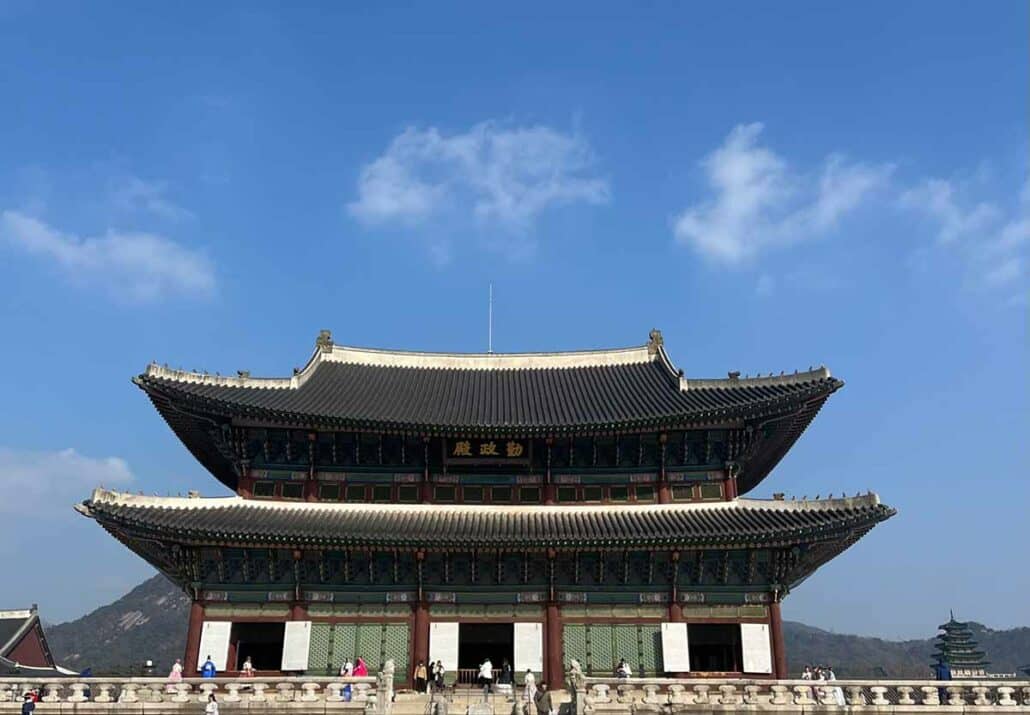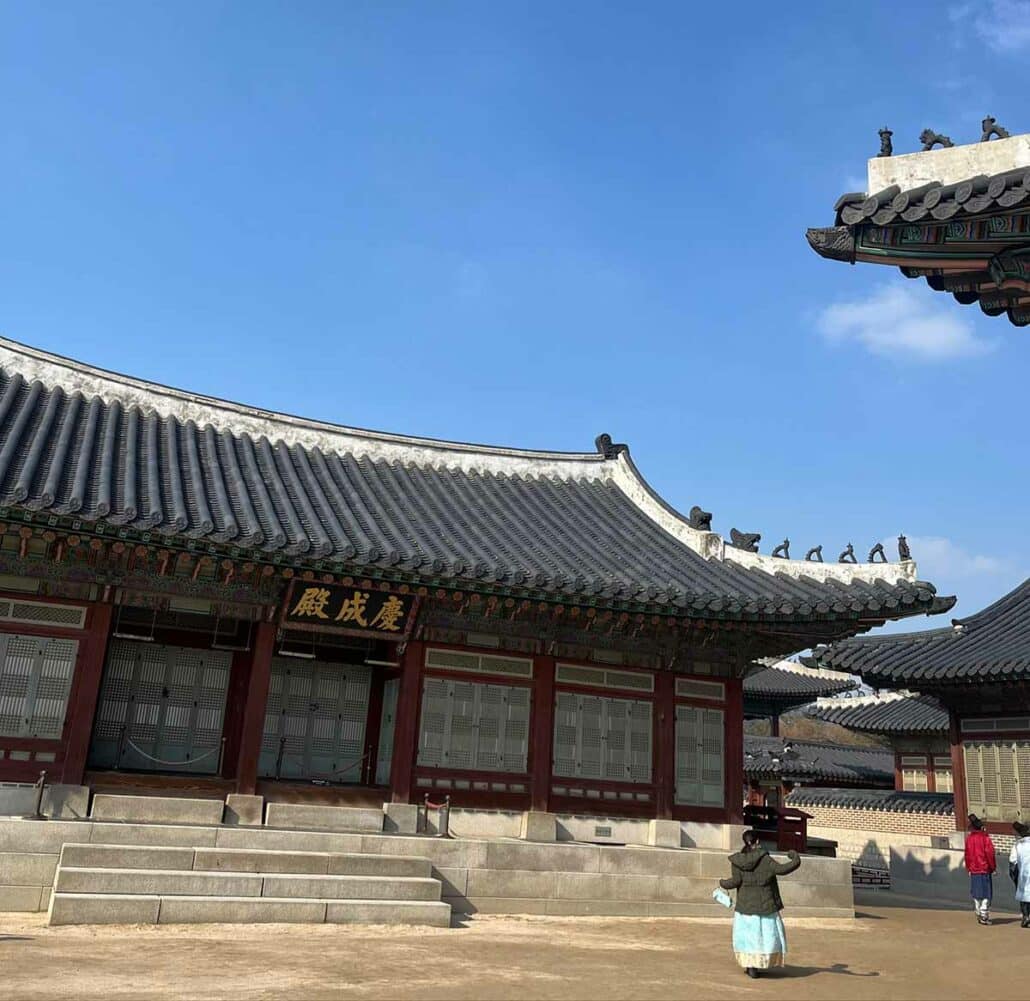Written by Victorine Gohy
Gyeongbokgung Palace, a majestic symbol of South Korea’s rich history and cultural heritage, stands proudly amidst the bustling streets of Seoul. Recently, Adventure Korea had the pleasure of guiding a group from the Singapore American School through this iconic landmark, offering them a captivating journey through time.

A Glimpse into the Past
As our group stepped through the grand gates of Gyeongbokgung Palace, they were immediately transported back to the Joseon Dynasty, a period spanning over five centuries from 1392 to 1910. Originally constructed in 1395 by King Taejo, the founder of the Joseon Dynasty, Gyeongbokgung served as the main royal palace and the seat of the Korean government.

A Symbol of Royal Power
Throughout its illustrious history, Gyeongbokgung Palace witnessed the rise and fall of numerous kings, political intrigues, and cultural shifts. The palace complex, with its sprawling grounds and intricate architecture, served as a symbol of royal power and authority. Each hall, pavilion, and courtyard within the palace walls holds a story waiting to be discovered.

Preserving Cultural Heritage
Despite facing destruction during invasions and wars, Gyeongbokgung Palace has been meticulously restored over the years, thanks to ongoing efforts to preserve South Korea’s cultural heritage. Our group from the Singapore American School had the opportunity to witness the grandeur of the main buildings, including Geunjeongjeon Hall, the throne hall where kings conducted state affairs, and Gyeonghoeru Pavilion, an exquisite structure set upon an artificial lake.

Immersive Learning Experience
Adventure Korea believes in providing not just sightseeing, but immersive learning experiences. Our guides enlightened the students from the Singapore American School about the significance of each architectural feature and the historical events that unfolded within the palace walls. From royal ceremonies to court rituals, the students gained a deeper understanding of Korea’s rich cultural traditions.

Exploration and Discovery
After learning about Gyeongbokgung’s history, the students were given time to explore the palace grounds at their own pace. They wandered through the picturesque gardens and marveled at the intricate details of the palace structures.It was a chance for them to connect with Korea’s past in a meaningful way.

Useful information:
Address : Gyeongbokgung Palace, 161, Sajik-ro, Jongno-gu, Seoul
Website : www.royalpalace.go.kr
Phone number : +82-2-3700-3900-1
Changing of the guard ceremony: 10:00 and 14:00 in the square inside Gwanghwamun Gate
Gate guard duty performance: 11:00 and 13:00 directly outside the Gwanghwamun Gate
How to go to Gyeongbokgung Palace:
- Subway: you can take Line 3 (orange) and get off at Gyeongbokgung Station Exit 5 or you can take Line 5 (purple) and get off at Gwanghwamun Station Exit 2.
- Bus: All optional bus routes: 0212, 1020, 1711, 7016, 7022, 1020, 109, 171, 272,602, 602-1 (Airport Bus), 606, 7025, 708, 9708.
- Walking: The palace is located at the Southern end of the Jongno-gu district in Seoul and is close by the Bukchon Hanok Village, Changdeokgung Palace and multiple museums so it’s easy to combine many activities in that area.
Opening Hours:
*Closed on Tuesdays*
The opening hours vary throughout the year:
- Mar – May and Sep – Oct – 09:00-18:00 (Last admission 17:00)
- Jun – Aug – 09:00-18:30 (Last admission 17:30)
- Nov – Feb – 09:00-17:00 (Last admission 16:00)
Entrance Fee:
You can purchase your tickets at the ticket office located inside the square at Gwanghwamun Gate.
- Entrance fee for an adult: 3000 KRW
- Entrance fee for non-Koreans: Adults (Ages 19-64) 3000 KRW / Junior (Ages 7-18) 1500 KRW / Group admission (10+ people) 2400 KRW
*Children (6 and under) and Seniors (65 and over) can visit for free
How long do you need to spend at the palace:
If you plan on doing the guided tour at Gyeongbokgung palace, I would recommend staying 1 hour for the tour and 1 extra hour to explore by your own and maybe even rent a Hanbok and take some nice photos!
What’s the best time to visit Gyeongbokgung palace?
The best time to visit Gyeongbokgung Palace is typically during the spring or autumn seasons. During these times, the weather is usually mild and pleasant, and the natural surroundings of the palace, such as the cherry blossoms in spring or the foliage in autumn, add to the beauty of the experience.
Spring, particularly from late March to early April, is a popular time to visit due to the cherry blossom season, when the palace grounds are adorned with beautiful pink blossoms. Autumn, from late September to early November, is also a fantastic time to visit, as the foliage surrounding the palace turns vibrant shades of red, orange, and yellow, creating a picturesque backdrop.
Additionally, visiting Gyeongbokgung Palace during weekdays and early mornings can help you avoid crowds, allowing for a more peaceful and enjoyable experience. However, it’s always a good idea to check the palace’s operating hours and any special events or closures before planning your visit.
Conclusion
Gyeongbokgung Palace stands as a testament to South Korea’s enduring spirit and cultural identity. Through Adventure Korea’s guided tour, the students from the Singapore American School not only witnessed the grandeur of this historic landmark but also gained a deeper appreciation for Korea’s rich history and traditions. As we continue to share these experiences with travelers from around the world, we hope to inspire a greater understanding and appreciation for the wonders of South Korea’s past.





